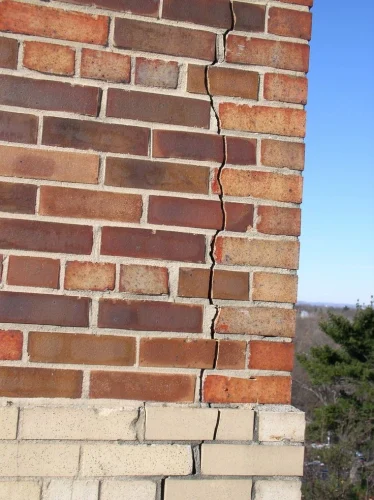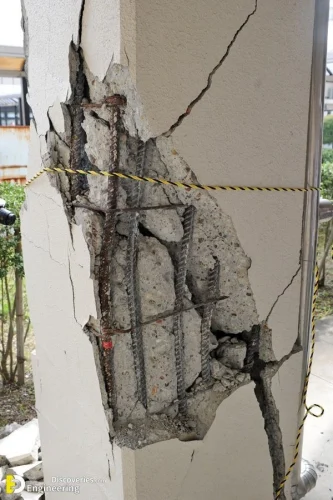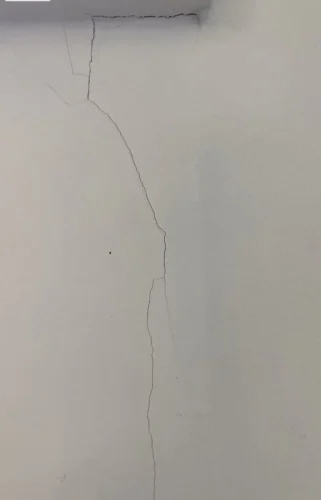
Which Is the Best Cement for House Construction in India? A Complete Guide for Homeowners
April 19, 2025
Trending Texture Design for Front Elevation in 2025
April 21, 2025Cracks in buildings are one of the wildest dreams for any homeowner. Whether you are using the best material during construction or not, different types of building cracks are very common over time.
Despite being a common thing in most houses, if not addressed on time, it can create structural damage. Also, before addressing the problem, it is important to understand the root cause of the cracks.
What are the causes of cracks in buildings?
Cracks in buildings happen for a few main reasons. First, the ground under the building can move. This can happen when the soil settles after the building is made or if the ground freezes and thaws. This movement can push and pull on the building, causing it to crack.
Second, the stuff buildings are made of changes over time. Concrete shrinks as it dries, and all materials expand and shrink when the weather gets hot and cold. If the building isn't built to handle these changes, it can crack. Sometimes, bad building work or not planning properly can also lead to cracks. Things like water and cold weather can make these problems worse over time.
Different Types of Building Cracks
Source: Pinterest
Cracks in buildings can be categorized into two main types: structural and non-structural. Each type of building crack has its distinct characteristics and implications:
Structural Cracks
Source: Pinterest
Structural cracks occur due to significant foundation movement, design flaws, or construction defects. These cracks can be a serious threat to the safety of the structure and require immediate attention from a qualified professional.
The structural cracks are typically wider than 1/8 inch or 3mm and have irregular patterns. These cracks also accompany other signs of structural issues like sloping floors and sticking doors or windows.
Different Types of Building Cracks (Structural):
Here’s the list of building structural crack types:
- Settlement Cracks: They occur due to uneven settling of the foundation.
- Shear Cracks: They result from forces causing parts of the structure to slide past each other.
- Flexural Cracks: They are caused by bending stresses, often in beams or slabs.
- Foundation Cracks: They are caused by soil movement or inadequate support in the foundation.
- Diagonal Cracks: They occur due to significant structural movement.
- Horizontal Cracks: These indicate serious foundational issues.
Non-Structural Cracks
Source: Pinterest
Non-structural cracks are typically superficial and do not affect the building's overall strength. They are often caused by the natural movement of building materials, such as shrinkage or thermal expansion. While generally not dangerous, they can be unsightly and may allow moisture to penetrate, leading to further problems.
The gaps in nonstructural cracks are narrow, usually less than 1/8 inch or 3mm. These cracks tend to have a more uniform appearance, but they don’t get worse over time.
Different Types of Building Cracks (Non-Structural):
Here’s the list of building non-structural crack types:
- Hairline Cracks: Very fine cracks on the surface.
- Shrinkage Cracks: Occur as concrete or plaster dries and shrinks.
- Thermal Cracks: Result from expansion and contraction of materials due to temperature changes.
- Crazing Cracks: A network of fine, shallow cracks on the surface of concrete or plaster.
How to Fix Different Types of Building Cracks?
Here's how you can fix different types of building cracks:
- Evaluate the Damage
The first step in addressing a crack is to accurately determine its nature. Is it a structural crack, which compromises the building's stability, or a non-structural crack, which is primarily a surface-level issue? It's also important to measure the crack's width, as this measurement will guide the selection of appropriate repair materials.
- Prioritize Safety
When dealing with cracks, safety should always be your top priority. If there's any suspicion that a crack might be structural, it's essential to work with caution. Even for minor repairs, it's advisable to wear appropriate safety gear, including gloves, eye protection, and a mask, to minimize exposure to dust and debris.
- Prepare the Area
Before applying any repair materials, the crack needs to be properly prepared. This involves thoroughly cleaning the area to remove any loose debris, dirt, dust, and any existing paint or sealant. For some types of repairs, particularly those involving larger cracks, it may be necessary to widen the crack slightly. This technique helps the repair material adhere more effectively, resulting in a stronger and more durable repair.
- Select the Materials
The selection of appropriate repair materials is crucial for achieving a successful and long-lasting repair. A wide variety of materials are available, and the best choice depends on the specific characteristics of the crack, including its type, size, and cause. If you're unsure about which material to use, seeking advice from a hardware store or a qualified professional is recommended.
- Apply and Finish
The final step involves applying the chosen filler material carefully and precisely. It's essential to ensure that the entire crack is filled, leaving no voids or gaps. A tool like a putty knife or trowel can be used to smooth the applied material, creating a flush and even surface that blends seamlessly with the surrounding area. Once the repair material has fully cured, painting over it can help to further conceal the repair and achieve a more aesthetically pleasing result.
Also Read: How to Stop Water Leakage from the Wall
Conclusion
Building cracks are a common thing in most Indian households, and repairing them effectively requires a systematic approach. By accurately evaluating whether it's a structural crack or a non-structural crack is important. You can ensure a long-lasting and structurally sound repair after identifying the damage, prioritizing safety, preparing the area, selecting the correct materials, and applying them carefully. Take a professional consultation to safeguard the integrity of the building and prevent future problems.
Also Read: Steps for building a foundation
Green Fortune Doors and Windows
At Green Fortune, we specialize in the manufacturing and supply of uPVC windows and doors. We emphasize on tech-driven approach, providing high-quality, durable, and energy-efficient solutions. Our products are designed to enhance your house's aesthetics and functionality. Explore our range of customizable options here.
Also Read: How to Repair a Wall Crack at Home
Frequently Asked Questions (FAQs)
Q1. Which cracks are serious?
A: Cracks that are wider than 5 mm are generally serious. Also, horizontal and diagonal cracks, as well as cracks above doors or windows that allow daylight or are growing rapidly, are concerning.
Q2. When to worry about house cracks?
A: Worry about house cracks that are wider than the hairline, horizontal, diagonal, above openings, growing, or accompanied by other structural issues like sticking doors or uneven floors.
Q3. What kind of cracks show foundation issues?
A: Foundation issues are often signaled by horizontal cracks in foundation walls and stair-step cracks in brick or block. Other indicators include diagonal cracks from openings, large vertical cracks in the foundation, and related cracks appearing in interior walls or ceilings.







